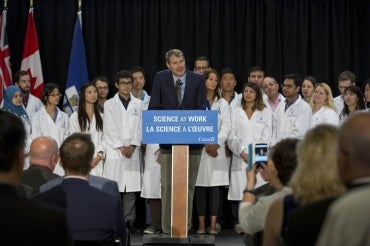$27-million Medicine by Design investment will fast-track stem cell research

Published: August 25, 2016
David McMillen and his team are hard at work designing a new custom-designed probiotic to help the 233,000 Canadians living with Crohn’s and colitis.
The goal of the project, which is among 20 sharing $27 million in funding from university’s newly created Medicine by Design initiative, is to create a bacterium that can help trigger the renewal of the gut lining in people with these chronic bowel diseases.
McMillen, a professor in University of Toronto Mississauga’s Department of Chemical & Physical Sciences, is among 75 leading scientists, engineers, doctors and mathematicians working on the 20 team projects, which range from attempting to improve failing eyesight in aging populations to treating heart and liver diseases.
“These projects are bringing together leading life scientists, engineers, doctors and computer scientists at U of T and our partner hospitals to tackle and solve some of the biggest hurdles in regenerative medicine,” said Meric Gertler, president of the University of Toronto, “I look forward to seeing discoveries emerging from these projects that will transform the way we develop cures to devastating diseases.”
See the full list of funded projects.
Regenerative medicine focuses on using stem cells to repair and regenerate damaged tissues and organs. Researchers involved in Medicine by Design are also investigating how drugs, molecules and genes can be used to prompt the body to repair itself. In the McMillen proposal, things are being taken one exciting step further by exploring the use of engineered bacteria.
 “This is a tremendously exciting project and we've assembled a great team to work on it,” said McMillen (left), which includes combines a wealth of expertise from a wide variety of areas such as synthetic biology, molecular genetics, intestinal stem cell signalling, biological/chemical engineering and bioinformatics.
“This is a tremendously exciting project and we've assembled a great team to work on it,” said McMillen (left), which includes combines a wealth of expertise from a wide variety of areas such as synthetic biology, molecular genetics, intestinal stem cell signalling, biological/chemical engineering and bioinformatics.
“I think it's fair to say that we were a bit unusual among the Medicine by Design projects, which are largely about working directly on or with human stem cells, tissues or organs, so the ‘bacteria team’ is a bit of an outlier,” he added.
“But the gut microbiome is now often being called a neglected ‘organ.’ Its importance to human health is similar to any organ in the body, even if it's not made of human cells.
“The interface between those bacteria and the health of the human they live in is subtle and complex, but a recent spike in research attention makes it clear that it has important and wide-reaching implications in diseases ranging from inflammatory bowel disease to metabolic diseases and immune disorders.”
Last summer, the federal government gave the University of Toronto the largest single research award in its history — $114 million — to support Medicine by Design, which builds on a rich legacy of U of T contributions to regenerative medicine, starting with the identification of blood stem cells by biophysicist James Till and hematologist Ernest McCulloch in 1960. This discovery was instrumental in the use of blood stem cell transplants to treat diseases such as leukemia.
The funding for Medicine by Design was the first grant announced under the government’s Canada First Research Excellence Fund.
In the decades since the Till and McCulloch discovery, stem cells have come to be seen by scientists as potentially offering ways to treat — and perhaps cure — a host of devastating and costly illnesses such as cardiovascular disease, cancer, diabetes, blindness and neurodegenerative disorders.
Globally, the regenerative medicine industry is expected to grow in value to tens of billions of dollars in the next five years.
“In addition to researching fundamental questions, the Medicine by Design projects include innovations slated to be ready for clinical trials within a few years, as well as enabling technologies with the potential to accelerate their cost-effective implementation,” said Vivek Goel, U of T’s vice-president of research and innovation.
“They will help strengthen U of T’s reputation as a global centre in the growing field of regenerative medicine and cell therapy, power Toronto’s vibrant biomedical ecosystem and — most importantly — lay the foundation for improved outcomes for patients around the world,” he said.
The funding marks Medicine by Design’s first investment in collaborative team projects.
The teams were selected through a rigorous competitive process, which involved international reviewers and Medicine by Design’s scientific advisory board, which is composed of eight global academic leaders in regenerative medicine.
“These projects launch at a very exciting time in biomedical research. We are accelerating the use of engineering design principles and quantitative biological modelling to nurture innovative environments where breakthroughs will emerge. That’s what Medicine by Design is all about,” said Peter Zandstra, executive director of Medicine by Design, the Canada Research Chair in Stem Cell Bioengineering and a professor in the Institute of Biomaterials & Biomedical Engineering.



